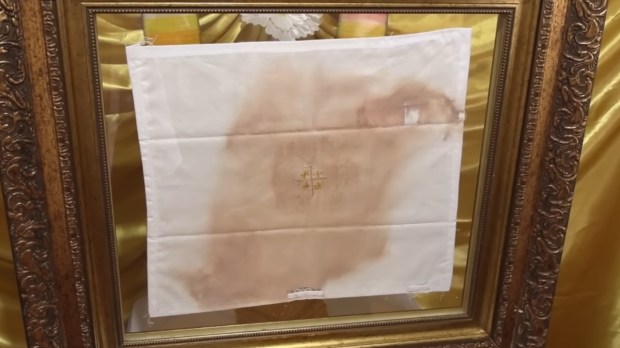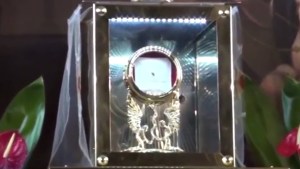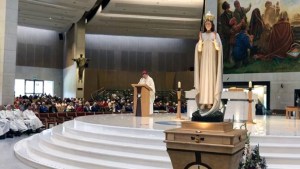An unusual event in an unknown place in Honduras
El Espinal is a small rural parish of about 60 families living scattered in the hills near the city of San Juan. There is no resident priest to minister there on a daily basis. The extraordinary minister of Holy Communion, José Elmer Benítez Machado, conducts regular services there. On Thursday, June 9, 2022, feast of Jesus Christ the High Priest, he observed something unusual in the tabernacle.
According to CNA, about 15 families were attending the regular Thursday prayer service. At five o’clock in the afternoon, the Liturgy of the Word and the rite of Holy Communion had begun. When José Machado opened the tabernacle, he saw something that looked like blood stains on the corporal, which was wrapped around the wooden ciborium containing the Blessed Sacrament.
“When I opened the tabernacle (…) I saw that amazing and marvelous gift of God for the Church, for Honduras, let’s say, for the whole world,” he told HCH. “Because when I saw it, I felt a sensation in my heart.”
“I was amazed,” he said in an interview with EWTN News. “My first hope was: ‘This is the Blood of Christ.’” He mastered his emotions and completed the rite. When he finished, he asked those gathered if anyone had seen the chapel’s roof leaking, thinking that perhaps it was a water stain. When all denied it, he told them what he had seen. Those gathered were convinced that it was a miracle.
A great deal of caution
Fr. Marvin Sotelo and Fr. Oscar Rodriguez, Sacred Heart missionaries who had recently been ministering in the village, arrived at the chapel from San Juan. They saw what had happened, spoke with the witnesses, and took the corporal, enclosing it in a sealed container.
They took it to Bishop Walter Guillén Soto, ordinary of the Diocese of Gracias in Honduras. He acted very cautiously.
“I’m not that prone to naively believing in things. Logic makes us prudent in terms of believing things without sifting through them and without analyzing them,” he told EWTN News.
After three months, the bishop transferred the corporal to the Santa Rosa de Copán Medical Center. They were lacking the necessary resources to perform an analysis, so the corporal was transferred to the DISA Test toxicology center in Tegucigalpa, where Héctor Díaz del Valle, a doctor in chemistry and pharmacy, directed an investigation.
At the end of October 2022, the material was examined by a forensic expert and a toxicology expert.
Surprising results
The tests ruled out that the stains were wood resin from the ciborium or animal blood. They also showed that the stain was not a pigment or other substance. The material was found to be free of fungus, mold, and contamination, despite the time that had passed since the stain was discovered.
Instead, tests showed that the stains on the corporal are indeed blood. Fr. Marvin Sotelo told HCH the results: “Indeed, it is human blood. […] The blood type is AB+, which is the blood type of all the Eucharistic miracles.”
Blood of the same type was found, for example, during the examination of the miracle of Lanciano and the Shroud of Turin.
God chooses the humble
Bishop Walter Guillen Soto announced the results of the study and acknowledged that the results were humanly inexplicable. He said:
I think that this extraordinary, visible, tangible, perceptible, verifiable sign of this manifestation of the blood of the Lord in an obscure community in the midst of the most extreme rurality of our agricultural environment says a lot at this time.
He stressed that it was unique that Jesus showed this miracle not to a clergyman or religious, but to a layman. He called it a “miracle of synodality.”
“It’s the time of the laity,” the bishop said. “It is the faith of the laity that has kept alive the vitality of the Church in these corners of the world. For me and for the clergy of the diocese it has been a call to conversion to recognize the call of God in the voice of the laity.”
When asked about the meaning of the miracle, Fr. Sotelo told HCH, “Each person is going to interpret this event in their own way. I think it’s a call to conversion.”
All the material was handed over to the Vatican for the final verification of the Eucharistic miracle.




